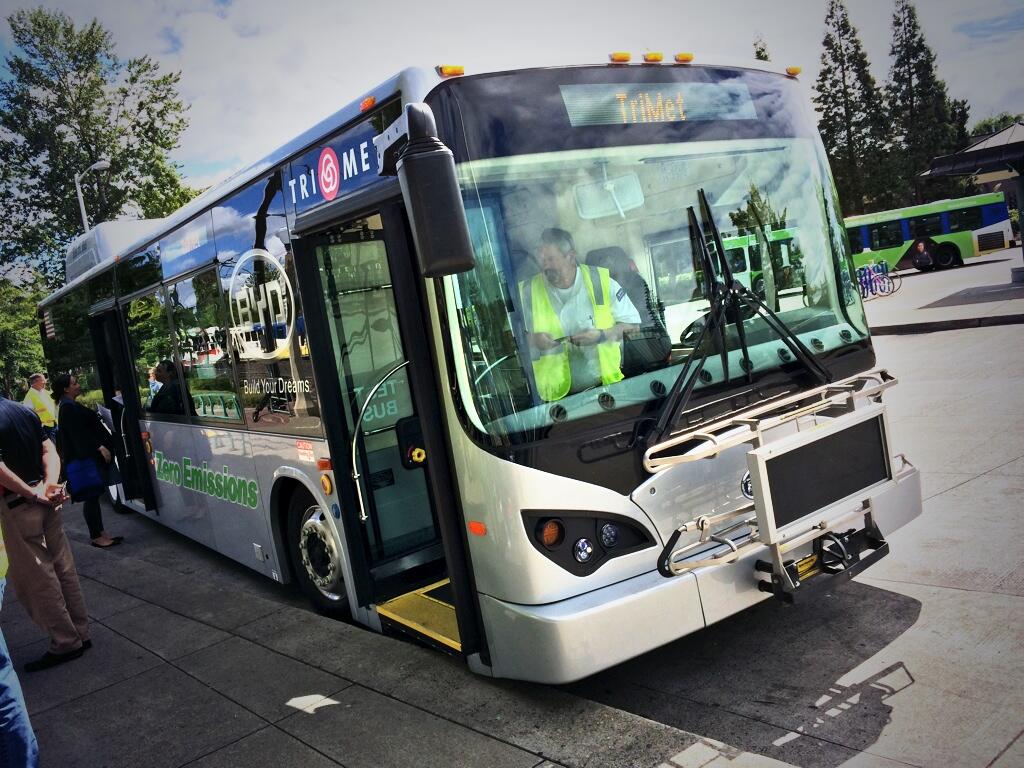Lane Transit District in Eugene and TriMet in Portland have both recently obtained funding to add electric buses to their transit fleets, cutting both air pollution and costs. Lane Transit District estimates the purchase will reduce lifetime fuel and maintenance costs by nearly $500,000 per bus, while TriMet’s grant will replace four diesel buses, which together burn through 35,000 gallons of fuel a year. Check out the full article below from the Portland Tribune to learn why going electric is great for TriMet’s business, our community, and our planet.
“Thanks to a $3.4 million federal grant, TriMet is adding electric buses to its fleet.
It’s another step forward for the regional transit agency, which is reflecting an industrywide shift toward more sustainable transportation methods. TriMet already has eight hybrid buses in its fleet of about 675 buses and with the federal grant will be adding four electric buses in 2018.
Long term, TriMet expects the industry will transition from diesel engine buses to electric ones, says Andrew Longeteig, TriMet spokesman. “We are very interested in moving in this direction, but we have to be careful and methodical because it is expensive,” he says.
TriMet doesn’t expect to line its bus routes with overhead electric lines as done in other cities. Rather, it is banking on the use of battery-operated buses, similar to the technology used in electric cars.
Battery-electric buses cost about $900,000 each, roughly twice as expensive as diesel-fueled buses. Thanks to better battery technology, that’s about 25 percent less than the $1.2 million they cost three years ago.
Even with the steep cost, transit agencies across the country are adding them to their fleets.
Portland-based TriMet is one of 20 agencies to receive funding in this latest round of federal grants to buy or lease low-emission or no-emission buses from the Federal Transit Administration’s Low or No Emission Vehicle Program. Lane Transit District, which serves Eugene and Springfield, also received nearly $3.48 million in grant funding to buy zero-emission battery-electric buses.
Electric buses are quieter then diesel buses.
They operate on battery packs and electric motors instead of fuel tanks and combustion engines, so they improve air quality by producing fewer carbon emissions and greenhouse gases. Those emissions are lower to the extent that electricity can be produced from wind, solar, hydro and other renewable energy.
Electric buses also are considered more reliable, in part due to their simpler mechanics. With no engine, transmission, intake or exhaust, maintenance costs also plummet.
Oh, and the fuel efficiency equivalent is “insane,” Longeteig says. Between all four buses, “We will save about 35,000 gallons of fuel a year,” he said.
The grant also covers depots and on-route charging infrastructure. Each bus will have a 100-kilowatt charger dedicated to it, allowing it to charge overnight. “We also have a mobile charger to top off a battery,” if a bus gets low on energy en route, Longeteig says.
The buses won’t be operational until 2018, in part because TriMet must determine the most efficient routes to use the buses on. Each bus can travel about 100 miles per charge, which makes it suitable for about one-third of TriMet’s routes. Snow, rain, hills and/or heavy traffic also can require more electricity, Longeteig says.
TriMet will study how the buses perform and whether it makes financial sense to add more to the fleet.
New Flyer, which manufactures the Xcelsior XE40 electric buses that TriMet is buying, estimates customers can save up to $400,000 in fuel costs over the 12-year life cycle of a bus. “Plus there’s the environmental impact and potential operations benefits,” Longeteig adds.
Replacing four older diesel buses with new electric buses will prevent approximately 350 metric tons of carbon dioxide-equivalent emissions a year. That’s equal to the greenhouse gas emissions from 74 passenger cars driven for a year.
The buses also would prevent about 0.1 metric tons, or about 220 pounds, of fine particulate matter, which consists of breathable particles about as thick as a human hair, from being released annually.
In addition, 4 metric tons, or 8,840 pounds, of nitrogen oxides; 0.16 metric tons, or 330 pounds, of hydrocarbons; and 1.25 metric tons, or 2,756 pounds, of carbon monoxide emissions will be prevented annually.
The health benefits from electric buses are arguably the most significant. Multnomah County has the fourth-highest level of diesel soot of all U.S. counties — more than in Los Angeles County, according to data prepared by the Clean Air Task Force in Boston. Diesel engines are blamed for causing an estimated 450 deaths a year in Oregon, because of complications from the tiny particulates that get lodged in the lungs.”
